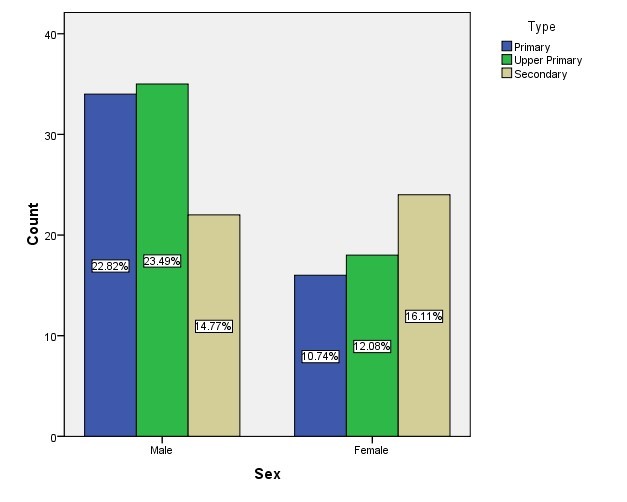Inter-rater reliability for visual acuity, refractive error, corneal reflex, and inter-pupillary distance among two masked optometrists in school children population
a pilot study
Abstract
Purpose: To observe the inter-rater reliability between the observers for visual acuity, refractive error, corneal reflex, and inter-pupillary distance.
Methods: A random subset of 50 students from primary (1st to 4th grade), higher primary (5th to 7th grade) and secondary school (8th to 10th grade), for a total of 150 students were selected by stratified sampling from the prevalence study VARES (Visual acuity, refractive error, and squint) performed among 1752 school children of Udupi district, India in 2013-2014. The Institutional Ethical Committee & District Health Administration board permission was acquired. There were two examiners: Examiner 1 (JT), a qualified optometrist with two years of experience, and Examiner 2 (MT), an optometry student. Examiners 1 and 2 performed a single measurement for visual acuity using the COMPlog computerized logMAR vision chart at 3 metres; Landolt C or Sloan letter optotypes used. Refractive error, corneal reflex, and inter-pupillary distance was measured by Plusoptix Power-refractor twice by Examiner 1 and thrice by Examiner 2; the average of each value was considered for analysis. Data was tested for normality using the Kolmogorov-Smirnov test. Statistical significance was considered p < 0.05. The agreement between the observers for the two procedures was traced by a Bland-Altman plot.
Results: The mean age of the students was 10.21 years (± 2.80 SD). The measurement of agreement for visual acuity (COMPlog) between the examiners was tested using Kappa statistics with 0.79 for OD, p < 0.05 and 1.0 for OS, p < 0.05 supported by Wilcoxon sign rank test showing 0.067 for OD and 0.564 for OS between the observers. The Bland-Altman plot also showed good agreement between the observers. Paired t-test for refractive error showed 0.117 (CI: -0.11–0.10) for OD & 0.067 (CI: -0.005–0.157) for OS, with Bland-Altman plot showing good agreement between the observers. Paired t-test showed 0.323 for corneal reflex and 0.520 for inter-pupillary distance.
Conclusion: From the results we report that there is no interobserver variability for visual acuity, refractive error, corneal reflex and inter-pupillary distance in school screening with COMPlog and Plusoptix A09.
References
2. Pararajasegaram R. VISION 2020-the right to sight: from strategies to action. Am J Ophthalmol. 1999 Sep;128(3):359-360.
3. Resnikoff S, Pascolini D, Mariotti SP, Pokharel GP. Global magnitude of visual impairment caused by uncorrected refractive errors in 2004. Bull World Health Organ. 2008 Jan;86(1):63-70
4. Rustagi N, Uppal Y, Taneja DK. Screening for visual impairment: outcome among schoolchildren in a rural area of Delhi. Indian J Ophthalmol. 2012;60(3):203-206.
5. Sudhan A, Pandey A, Pandey S, Srivastava P, Pandey KP, Jain BK. Effectiveness of using teachers to screen eyes of school-going children in Satna district of Madhya Pradesh, India. Indian J Ophthalmol. 2009;57(6):455-458.
6. Hussain B, Saleh GM, Sivaprasad S, Hammond CJ. Changing from Snellen to LogMAR: debate or delay? Clin Experiment Ophthalmol. 2006;34(1):6-8.
7. Laidlaw DA, Tailor V, Shah N, Atamian S, Harcourt C. Validation of a computerised logMAR visual acuity measurement system (COMPlog): comparison with ETDRS and the electronic ETDRS testing algorithm in adults and amblyopic children. Br J Ophthalmol. 2008;92(2):241-244
8. Dahlmann-Noor AH, Comyn O, Kostakis V, et al. Plusoptix Vision Screener: the accuracy and repeatability of refractive measurements using a new autorefractor. Br J Ophthalmol. 2009;93(3):346-349.
9. Allen PM, Radhakrishnan H, O'Leary DJ. Repeatability and validity of the PowerRefractor and the Nidek AR600-A in an adult population with healthy eyes. Optom Vis Sci. 2003;80(3):245-251.

Copyright (c) 2019 Asian Journal of Ophthalmology

This work is licensed under a Creative Commons Attribution 4.0 International License.
Authors who publish with this journal agree to the following terms:
- Authors retain copyright and grant the journal right of first publication, with the work twelve (12) months after publication simultaneously licensed under a Creative Commons Attribution License that allows others to share the work with an acknowledgement of the work's authorship and initial publication in this journal.
- Authors are able to enter into separate, additional contractual arrangements for the non-exclusive distribution of the journal's published version of the work (e.g., post it to an institutional repository or publish it in a book), with an acknowledgement of its initial publication in this journal.
- Authors are permitted and encouraged to post their work online (e.g., in institutional repositories or on their website) prior to and during the submission process, as it can lead to productive exchanges, as well as earlier and greater citation of published work (See The Effect of Open Access).


